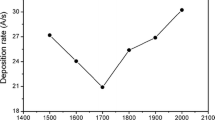Abstract
This work deals with the role of hydrogen dilution and filament temperature on the morphology, structure and electrical properties of nanocrystalline boron doped silicon carbide thin films produced by hot-wire technique. The structural and morphological data obtained by XRD, SEM and micro-Raman show that for filament temperatures and hydrogen dilutions above 2100°C and 90%, respectively, the surface morphology of the films is granular with a needle shape, while for lower filament temperatures and hydrogen dilutions the surface morphology gets honeycomb like. The SIMS analysis reveals that films produced with filament temperatures of about 2200°C and hydrogen dilution of 99% present a higher hydrogen and carbon incorporation than the films produced at lower temperatures and hydrogen dilutions. These results agree with the electrical and optical characteristics recorded that show that the films produced exhibit optical gaps in the range from 1.8 to 2 eV and transverse conductivities ranging from 10-1S/cm to 10-3 S/cm, consistent with the degree of films crystallinity and carbon incorporation recorded.
Similar content being viewed by others
References
H. Matsumura, Jpn. J. Appl. Phys. 25 (1986) 1949; J. Doyle, R. Robertson, G. H. Lin, M. Z. He, A. Gallagher, J. Appl. Phys., 64 (1988) 3215.
R. Martins, I. Ferreira, B. Femandes and E. Fortunato, Vacuum (1998), in press.
R. Martins, M. Vieira, I. Ferreira and E. Fortunato, Mat. Res. Soc. Symp. Proc. 358, 915 (1994).
E. Bustarret, M. A. Hachicha and M. Brunel, Appl. Phys. Lett. 52 (1987) 1675; C. Godet, B. Marchon and M. P. Schimdt, Thin Solid Films, 155 (1987) 227.
F. H. Pollak: Analitical Raman Spectroscopy, 1st edn. (Wiley, New York1991) pp. 137–214.
Z. Iqbal and S. Veprek, J. Phys. C 15 (1982) 377.
R. Martins, M. Vieira, I. Ferreira and E. Fortunato, J. Vac. Sci. Technol., vol. A13 n.4, p. 2199 (1995).
I. Ferreira, B. Femandes and R. Martins, Vacuum (1998), in press.
R. Martins, I. Ferreira, B. Femandes, E. Fortunato, J. Non-Crystalline Solids, (1998), in press.
Acknowledgement
The SEM, Raman and SIMS analysis were performed at NMRC (Ireland) in the framework of the project Large Scale Facility, and the authors are grateful to Mrs M. Mooney, S. Hearne and P. Roseingrove for the help given during the measurements. This work was supported by FCT through “Financiamento Plurianuais” of CENIMAT and through the projects PRAXIS/3/3.1/MMA/1788/95 and NATO SfS PO-THINFILM.
Author information
Authors and Affiliations
Corresponding author
Rights and permissions
About this article
Cite this article
Ferreira, I., Águas, H., Mendes, L. et al. Influence of the H2 Dilution And Filament Temperature on the Properties of P Doped Silicon Carbide Thin Films Produced by Hot-Wire Technique. MRS Online Proceedings Library 507, 831–836 (1998). https://doi.org/10.1557/PROC-507-831
Published:
Issue Date:
DOI: https://doi.org/10.1557/PROC-507-831




